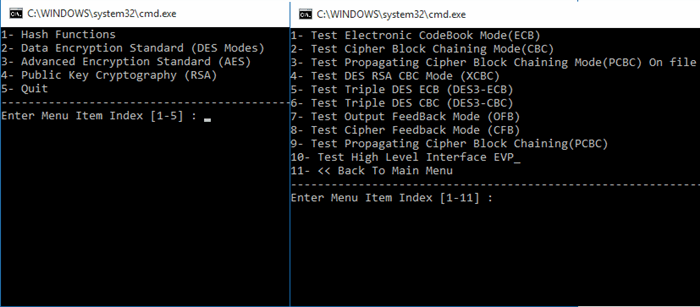Des Key Generation Program In C++
∟Introduction to DES Algorithm
∟DES Key Schedule (Round Keys Generation) Algorithm
This section describes DES (Data Encryption Standard) algorithm - A 16-round Feistel cipher with block size of 64 bits.
Key schedule algorithm:
DES key schedule supporting tables:
Hekate stuck on generated keys. Permuted Choice 1 - PC1:
Permuted Choice 2 - PC2:
Jun 10, 2016 Another modified version of the DES algorithm is famously known as Triple DES. The key generator method creates 16 48-bit keys. The key generator method creates 16 48-bit keys. Note: This implementation of simplified data encryption standard in C programming language is compiled with GNU GCC compiler on Linux Ubuntu 14.04 operating system. Data Encryption Standard is a draft programming task. It is not yet considered ready to be promoted as a complete task, for reasons that should be found in its talk page.
Des key generation Search and download des key generation open source project / source codes from CodeForge.com. Incidentally, there are two variants of Triple DES known as 3-key Triple DES (3TDES) and 2-key Triple DES (2TDES). 3-KEY Triple DES. Before using 3TDES, user first generate and distribute a 3TDES key K, which consists of three different DES keys K 1, K 2 and K 3. This means that the actual 3TDES key has length 3×56 = 168 bits. Data encryption standard (DES) has been found vulnerable against very powerful attacks and therefore, the popularity of DES has been found slightly on decline. DES is a block cipher, and encrypts data in blocks of size of 64 bit each, means 64 bits of plain text goes as the input to DES, which produces 64 bits of cipher text. Key generation in Simplified DES. DES means Data Encryption Standard. This c program will generate secure password - encryption key for simplified DES cryptographic algorithm.
Left shifts (number of bits to rotate) - r1, r2, .., r16:
Table of Contents
About This Book
Cryptography Terminology
Cryptography Basic Concepts
Introduction to AES (Advanced Encryption Standard)
►Introduction to DES Algorithm
What Is Block Cipher?
DES (Data Encryption Standard) Cipher Algorithm
►DES Key Schedule (Round Keys Generation) Algorithm
DES Decryption Algorithm
DES Algorithm - Illustrated with Java Programs
DES Algorithm Java Implementation
DES Algorithm - Java Implementation in JDK JCE
DES Encryption Operation Modes
DES in Stream Cipher Modes
PHP Implementation of DES - mcrypt
Blowfish - 8-Byte Block Cipher
Secret Key Generation and Management
Cipher - Secret Key Encryption and Decryption
Introduction of RSA Algorithm

RSA Implementation using java.math.BigInteger Class
Introduction of DSA (Digital Signature Algorithm)
Java Default Implementation of DSA
Private key and Public Key Pair Generation
PKCS#8/X.509 Private/Public Encoding Standards
Des Key Generation Program In C B
Cipher - Public Key Encryption and Decryption
MD5 Mesasge Digest Algorithm
SHA1 Mesasge Digest Algorithm
OpenSSL Introduction and Installation
OpenSSL Generating and Managing RSA Keys
OpenSSL Managing Certificates
OpenSSL Generating and Signing CSR
OpenSSL Validating Certificate Path
'keytool' and 'keystore' from JDK
'OpenSSL' Signing CSR Generated by 'keytool'
Migrating Keys from 'keystore' to 'OpenSSL' Key Files

Certificate X.509 Standard and DER/PEM Formats
Migrating Keys from 'OpenSSL' Key Files to 'keystore'
Using Certificates in IE
Using Certificates in Google Chrome
Using Certificates in Firefox
Outdated Tutorials
References
Full Version in PDF/EPUB
- Cryptography Tutorial
- Cryptography Useful Resources
- Selected Reading
The speed of exhaustive key searches against DES after 1990 began to cause discomfort amongst users of DES. However, users did not want to replace DES as it takes an enormous amount of time and money to change encryption algorithms that are widely adopted and embedded in large security architectures.
The pragmatic approach was not to abandon the DES completely, but to change the manner in which DES is used. This led to the modified schemes of Triple DES (sometimes known as 3DES).
Incidentally, there are two variants of Triple DES known as 3-key Triple DES (3TDES) and 2-key Triple DES (2TDES).
3-KEY Triple DES
Before using 3TDES, user first generate and distribute a 3TDES key K, which consists of three different DES keys K1, K2 and K3. This means that the actual 3TDES key has length 3×56 = 168 bits. The encryption scheme is illustrated as follows −
The encryption-decryption process is as follows −
Encrypt the plaintext blocks using single DES with key K1.
Now decrypt the output of step 1 using single DES with key K2.
Finally, encrypt the output of step 2 using single DES with key K3.
The output of step 3 is the ciphertext.
Decryption of a ciphertext is a reverse process. User first decrypt using K3, then encrypt with K2, and finally decrypt with K1.
Due to this design of Triple DES as an encrypt–decrypt–encrypt process, it is possible to use a 3TDES (hardware) implementation for single DES by setting K1, K2, and K3 to be the same value. This provides backwards compatibility with DES.
How To Program In C
Second variant of Triple DES (2TDES) is identical to 3TDES except that K3is replaced by K1. In other words, user encrypt plaintext blocks with key K1, then decrypt with key K2, and finally encrypt with K1 again. Therefore, 2TDES has a key length of 112 bits.
Des Key Generation Program In C
Triple DES systems are significantly more secure than single DES, but these are clearly a much slower process than encryption using single DES.
In short, the attention to detail that has been used in each and every aspect of Spore is spectacular. Spore key code generator download no survey.